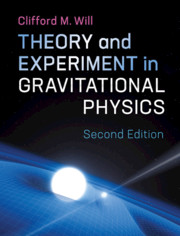Book contents
- Frontmatter
- Dedication
- Contents
- Preface
- Acknowledgments
- 1 Introduction
- 2 The Einstein Equivalence Principle
- 3 Gravitation as a Geometric Phenomenon
- 4 The Parametrized Post-Newtonian Formalism
- 5 Metric Theories of Gravity and Their Post-Newtonian Limits
- 6 Equations of Motion in the PPN Formalism
- 7 The Classical Tests
- 8 Tests of the Strong Equivalence Principle
- 9 Other Tests of Post-Newtonian Gravity
- 10 Structure and Motion of Compact Objects
- 11 Gravitational Radiation
- 12 Strong-Field and Dynamical Tests of Relativistic Gravity
- References
- Index
1 - Introduction
Published online by Cambridge University Press: 07 September 2018
- Frontmatter
- Dedication
- Contents
- Preface
- Acknowledgments
- 1 Introduction
- 2 The Einstein Equivalence Principle
- 3 Gravitation as a Geometric Phenomenon
- 4 The Parametrized Post-Newtonian Formalism
- 5 Metric Theories of Gravity and Their Post-Newtonian Limits
- 6 Equations of Motion in the PPN Formalism
- 7 The Classical Tests
- 8 Tests of the Strong Equivalence Principle
- 9 Other Tests of Post-Newtonian Gravity
- 10 Structure and Motion of Compact Objects
- 11 Gravitational Radiation
- 12 Strong-Field and Dynamical Tests of Relativistic Gravity
- References
- Index
Summary
We review the early history of the general theory of relativity and its subsequent decline to the backwaters of physics and astronomy. We describe the renaissance of the theory during the 1960s and the renewed effort to subject it to experimental tests using laboratory experiments, the solar system, binary pulsars, and finally in 2015, gravitational waves. We then discuss future directions for experimental tests in the strong-field and dynamical regimes.
- Type
- Chapter
- Information
- Theory and Experiment in Gravitational Physics , pp. 1 - 10Publisher: Cambridge University PressPrint publication year: 2018

